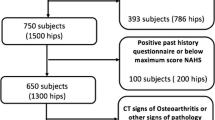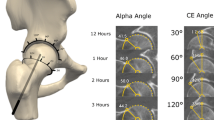Abstract
Objective
To examine the prevalence of herniation pits (HPs) and to evaluate differences in radiographic features related to femoroacetabular impingement—a hip disorder with abnormal abutment between the acetabulum and femur—between hips with and without HPs in a convenience sample of Japanese patients.
Materials and methods
We reviewed 1,178 hips on each side (695 men, 483 women; mean age, 58.2 years) using computed tomographic images. The radiological assessments of hip morphology were performed by measuring the lateral center edge angle, acetabular index, acetabular version, alpha angle, and femoral head-neck offset. HPs were defined as the round or oval cystic lesions surrounded by sclerotic bone located below the anterior femoral neck cortex.
Results
Intraclass and interclass reproducibility of all radiographic measurements was acceptable (ICC: 0.71–0.98). The prevalence of HPs was 13.9 % in all subjects and was significantly higher in men (18.1 %) than in women (7.8 %; p < 0.001). HPs were larger in male (p < 0.001) and elderly subjects (p < 0.005). In subjects with HPs, the alpha angle was larger and femoral head-neck offset and offset ratio were smaller in the cohort overall and in men. Logistic regression analysis revealed the association between radiological cam-type FAI and HPs in all subjects (odds ratio: 1.86, p < 0.001).
Conclusions
We revealed the prevalence of HPs and showed it has a predilection for men in this Japanese cohort. Femoral head asphericity or small head-neck offset was more common in subjects with HPs than those without HPs.







Similar content being viewed by others
References
Pitt MJ, Graham AR, Shipman JH, Birkby W. Herniation pit of the femoral neck. AJR Am J Roentgenol. 1982;138:1115–21.
Leunig M, Beck M, Kalhor M, Kim Y-J, Werlen S, Ganz R. Fibrocystic changes at anterosuperior femoral neck: prevalence in hips with femoroacetabular impingement. Radiology. 2005;236:237–46.
Kassarjian A, Yoon LS, Belzile E, Connolly SA, Millis MB, Palmer WE. Triad of MR arthrographic findings in patients with cam-type femoroacetabular impingement. Radiology. 2005;236:588–92.
Tannast M, Siebenrock KA, Anderson SE. Femoroacetabular impingement: radiographic diagnosis—what the radiologist should know. AJR Am J Roentgenol. 2007;188:1540–52.
Clohisy JC, Carlisle JC, Beaulé PE, et al. A systematic approach to the plain radiographic evaluation of the young adult hip. J Bone Joint Surg Am. 2008;90 Suppl 4:47–66.
Ganz R, Parvizi J, Beck M, Leunig M, Nötzli H, Siebenrock KA. Femoroacetabular impingement: a cause for osteoarthritis of the hip. Clin Orthop Relat Res. 2003;417:112–20.
Ganz R, Leunig M, Leunig-Ganz K, Harris WH. The etiology of osteoarthritis of the hip: an integrated mechanical concept. Clin Orthop Relat Res. 2008;466:264–72.
Panzer S, Augat P, Esch U. CT assessment of herniation pits: prevalence, characteristics, and potential association with morphological predictors of femoroacetabular impingement. Eur Radiol. 2008;18:1869–75.
Kim JA, Park JS, Jin W, Ryu K. Herniation pits in the femoral neck: a radiographic indicator of femoroacetabular impingement? Skelet Radiol. 2011;40:167–72.
Ji H-M, Baek J-H, Kim K-W, Yoon J-W, Ha Y-C. Herniation pits as a radiographic indicator of pincer-type femoroacetabular impingement in symptomatic patients. Knee Surg Sports Traumatol Arthrosc. 2013;22:860–6.
Guo Z, Xu L, Su Y-B, Cheng X-G. Correlation between the prevalence of herniation pits and the α angle of the hip: computed tomography evaluation in healthy Chinese adults. BMC Musculoskelet Disord. 2013;14:288.
Scheyerer MJ, Copeland CE, Stromberg J, Ruckstuhl T, Werner CML. Radiographic markers of femoroacetabular impingement: correlation of herniation pit and femoral bump with a positive cross-over ratio. Adv Orthop. 2014;2014:432728–5.
Panzer S, Esch U, Abdulazim AN, Augat P. Herniation pits and cystic-appearing lesions at the anterior femoral neck: an anatomical study by MSCT and microCT. Skelet Radiol. 2010;39:645–54.
Ergen FB, Vudalı S, Sanverdi E, Dolgun A, Aydıngöz Ü. CT assessment of asymptomatic hip joints for the background of femoroacetabular impingement morphology. Diagn Interv Radiol. 2014;20:271–6.
Lepage-Saucier M, Thiéry C, Larbi A, Lecouvet FE, Vande Berg BC, Omoumi P. Femoroacetabular impingement: normal values of the quantitative morphometric parameters in asymptomatic hips. Eur Radiol. 2014;24:1707–14.
Wiberg G. Shelf operation in congenital dysplasia of the acetabulum and in subluxation and dislocation of the hip. J Bone Joint Surg Am. 1953;35-A:65–80.
Tönnis D, Heinecke A. Acetabular and femoral anteversion: relationship with osteoarthritis of the hip. J Bone Joint Surg Am. 1999;81:1747–70.
Kopydlowski NJ, Tannenbaum EP, Bedi A, Smith MV, Sekiya JK. An increase in cranial acetabular version with age: implications for femoroacetabular impingement. J Arthroplasty. 2014;29:1741–4.
Nötzli HP, Wyss TF, Stoecklin CH, Schmid MR, Treiber K, Hodler J. The contour of the femoral head-neck junction as a predictor for the risk of anterior impingement. J Bone Joint Surg (Br). 2002;84:556–60.
Beaulé PE, Harvey N, Zaragoza E, Le Duff MJ, Dorey FJ. The femoral head/neck offset and hip resurfacing. J Bone Joint Surg (Br). 2007;89:9–15.
Montgomery AA, Graham A, Evans PH, Fahey T. Inter-rater agreement in the scoring of abstracts submitted to a primary care research conference. BMC Health Serv Res. 2002;2:8.
Kundel HL, Polansky M. Measurement of observer agreement. Radiology. 2003;228:303–8.
Daenen B, Preidler KW, Padmanabhan S, et al. Symptomatic herniation pits of the femoral neck: anatomic and clinical study. AJR Am J Roentgenol. 1997;168:149–53.
Nokes SR, Vogler JB, Spritzer CE, Martinez S, Herfkens RJ. Herniation pits of the femoral neck: appearance at MR imaging. Radiology. 1989;172:231–4.
Jingushi S, Ohfuji S, Sofue M, et al. Multiinstitutional epidemiological study regarding osteoarthritis of the hip in Japan. J Orthop Sci. 2010;15:626–31.
Hoaglund FT, Shiba R, Newberg AH, Leung KY. Diseases of the hip: a comparative study of Japanese Oriental and American white patients. J Bone Joint Surg Am. 1985;67:1376–83.
Crabbe JP, Martel W, Matthews LS. Rapid growth of femoral herniation pit. Am J Roentgenol. 1992;159:1038–40.
Acknowledgements
None of the authors received financial support for this study.
Author information
Authors and Affiliations
Corresponding author
Ethics declarations
Conflict of Interest
The authors declare that they have no conflict of interest.
Ethical approval
All procedures performed in studies involving human participants were in accordance with the ethical standards of the institutional and/or national research committee and with the 1964 Helsinki declaration and its later amendments or comparable ethical standards.
Informed consent
Institutional Review Board approval was obtained for this study and in accordance with the requirements of a retrospective review; informed consent was not required.
Rights and permissions
About this article
Cite this article
Mineta, K., Goto, T., Wada, K. et al. Comparison of femoroacetabular impingement-related radiographic features in a convenience sample of Japanese patients with and without herniation pits. Skeletal Radiol 45, 1079–1088 (2016). https://doi.org/10.1007/s00256-016-2393-8
Received:
Revised:
Accepted:
Published:
Issue Date:
DOI: https://doi.org/10.1007/s00256-016-2393-8




